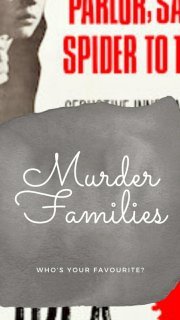C.M. Rosens's Blog, page 42
February 4, 2021
Podcast Launch! Chapter 1: The Creepy Old House
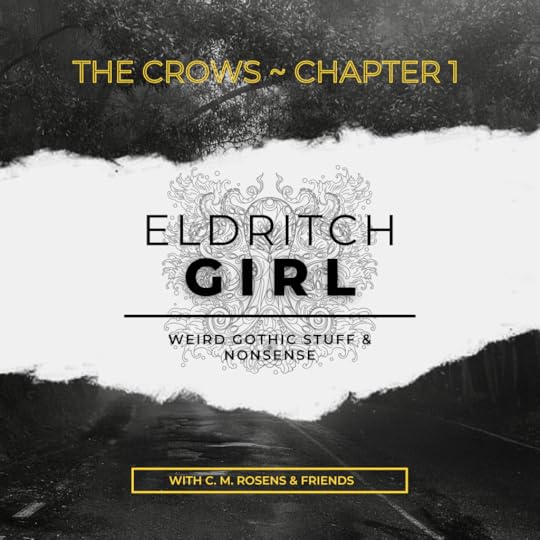
Check out Chapter 1 of THE CROWS, now on Spotify and RSS.com!
CHAPTER 1: THE CREEPY OLD HOUSE
Links on my Podcast page.
… in which Carrie Rickard has 33 days left to live…
“You won’t fit in there, Caroline.” Her mother’s warning was issued in the ringing, decisive tones of a fait accompli, the culmination of her ten-minute diatribe against Carrie’s decision. Any anxieties she’d felt at passing her quarter- centenary faded away as her mother stripped her development back by ten years.
C. M. Rosens, The Crows, p. 1
Carrie stood in one of the smaller back bedrooms of her new, finally-finished property, holding the phone away from her ear. Her lower lip had split from raking her teeth over it; blood tanged on her tongue.
“I’m staying,” Carrie repeated.
Few people tried to stand up to Margaret Rickard, and fewer still succeeded. The teddy on top of Carrie’s wardrobe looked on, glass eyes dusty and judgemental.
A beat. “You’re not… punishing yourself, are you, sweetheart?”
All the chapters in the novel are named after my favourite Gothic tropes, or at least, tropes that pop up in the chapter in some form. I wrote a post on The Creepy Old House trope here. Check it out with the podcast episode! Tasty additional content.
If you are interested in how I constructed Fairwood House/The Crows, I talk about it in more detail on the Left Page Podcast that aired last week! That was a lot of fun, and we talked about elite spaces vs working class spaces, but also how I conceptualised my sentient house and its personality.
If you want me to reprise that for a bonus episode and get into it a bit more, and maybe focus on some of the history of the house, then let me know…
January 30, 2021
Gothic Day of Creation: Dialogue Workshop
Today is the Gothic Day of Creation over at Romancing the Gothic project, with so much good stuff going on! I kicked us off with a dialogue workshop, and if you missed it, here are some highlights for you…
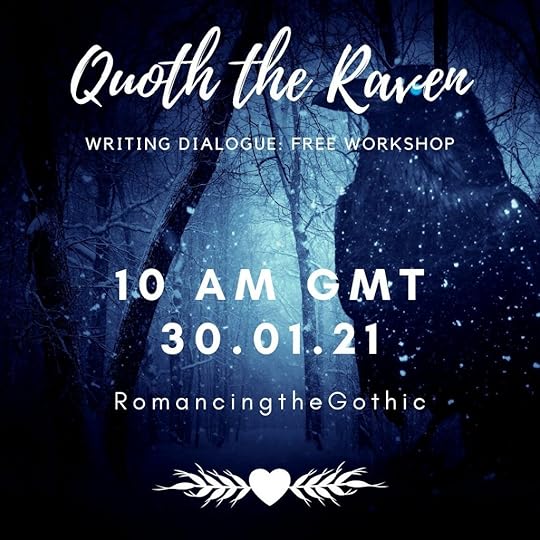
Choose your characters for the workshop. You need Character A and B. Pick a Gothic trope to form the basis of their discussion, drop them into a setting and let one character have a piece of information that the other one needs to know.
Consider dialect, idioms and accents and build them into your worldbuilding for the scene, the character backstory, and be aware of not appropriating the modes of speech used by minority groups you do not belong to.
Resources can include dialect dictionaries and YouTube recordings of extinct or dying or rare accents and dialect. I’ve used www.sussexhistory.co.uk/sussex-dialect/Sussex-dialect.html which you can buy as a hard copy but also is free here online. Dialect dictionaries are great because some of them – like this one – tell you origins of the words and idioms (they may not be correct in all cases but they give a good flavour of the dialect, etymology and perceptions of it at the time the dialect dictionary was compiled).
What points of contact does your world have?Who mixes with whom?How does the history of your character’s home affect their vocabulary and speech patterns?Do other characters understand them all the time?Do your characters start picking up each other’s words and phrases?When do your characters code-switch? Under what circumstances do your characters slip into a different accent to their normal one and why?Dialect can be used as a marker of class and this is not always a good thing. It can intersect with other kinds of prejudices, and betray complicated dynamics among your characters if they are from different – or even the same – socio-cultural/religious/political/ethnic background.
Decide whether the two characters you picked are from the same or different kind of background, and how this will translate into the dialogue. What bundle of preconceptions and stereotypes accompany their first impressions of each other and how do their accents/dialects play into this?
Subversive dialogue! Language is as much about the artful failure to communicate as it is about communication… How can you play with constructed dialects/actual ones, riddles, idioms etc, so that the characters reveal everything the protagonist needs to know, but in such a way that the protagonist does not immediately understand they now have all the information they need? The unraveling of meaning can then be part of the central mystery. It can also add tension if the reader understands before the protagonist does.
Pick Character A or B to impart some info to the other one. How are they going to do it and will B understand?
Go over your dialogue and read it out loud. How do you render pauses, repeated words (when people stumble or need time to think), words they rely on to fill gaps as they think like “um”, “er”, or “like”, or a swear word, and so on? What about emphasis – words or individual syllables? How can you represent this on the page?
Exercise for Homework: find a short video or soundbite of people speaking naturally. Transcribe it as closely as you can, with all the pauses, repeated words, punctuation to represent their syntax and rhythm of speech, etc. Don’t correct errors like mispronounciation or idioms that they get wrong. This might give you ideas around how to transpose this onto fictional characters in your own writing.
If you enjoyed my workshop or like these tips, feel free to buy me a coffee!
January 29, 2021
Left Page Interview ~ C. M. Rosens & THE CROWS

Hi folks! I got to do an interview on The Left Page podcast (in English, but based in Brazil) with Frank Lopes, now hosting solo as his co-host Bruno has had to step down. It’s a really fun podcast discussing literature from a left perspective. I’m Episode 31!
The introduction (first aired 13 Feb 2019) can be found here. The full episodes are around an hour long. For those of us who love the Gothic and the Weird, here are some episodes you might be especially interested in…
Episode 11 – The Grey Out of Capitalism. A First Look at Lovecraft
Episode 14 – The Spectral Black Cat of Edgar Allan Poe
Episode 24 – Blood and Revolution. Werewolves in the Paris Commune (this one looks at Guy Endore’s novel which I’ve discussed in my series of posts on Werewolf Films, first one here)
Episode 27 – Lighting Beacons Against Ligotti’s Ichor of Darkness. With the Horror Vanguard
Episode 29 – ‘Tis the Season [for Rioting]. A Christmas Tale from China Miéville
Plus episodes on Asimov, Dostoyevski, Borges, Vonnegut, Bulgakov, and more!
It’s really exciting to have The Crows discussed alongside stories and novels like these, so I hope my rambling about class and the Gothic is at least entertaining. And maybe you’d like to buy the book if you’re interested in those sorts of things, and see something else in it. Ultimately, what you do with the themes is up to you!
You can always listen to me reading it out (without doing the accents) on my own podcast, launching 4th Feb 12pm GMT.
You can access it directly on my Podcast page, on Spotify, Apple, and/or Google Podcasts. Make sure you check out the content warnings…
See you on the 4th! Check out the schedule for the whole month of February here.
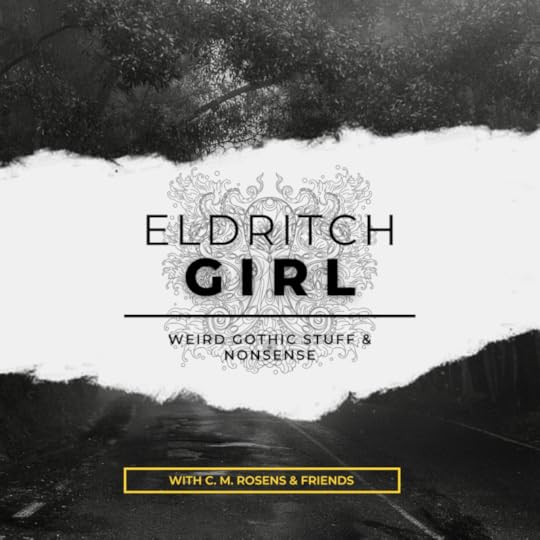 Looking forward to seeing you soon…
Looking forward to seeing you soon…
January 28, 2021
Tell me your favourite murder family here or Insta! Question in my Instagram story…
January 25, 2021
Horror Podcast ~ Schedule for February 2021
Hi folks! I’m really excited for the podcast launch and I hope that you are too. Here’s a look at what’s coming up in February… I will be doing one author interview a month, plus additional bonus episodes as we go through. There are 6 episodes to look forward to this coming month, all about 30mins in length. The Crows theme tune is by Gemma Cartmell, and the Bonus Episode samples ‘Netherworld Shanty‘ by Kevin MacLeod. All the sound effects sampled and used are royalty free.
Each of the Author Interview episodes will appear with its own transcript posted here on the blog, with the author’s bio, extract (quoted with permission only), and the text of the interview. I’ll also add in all the links for you to access their websites, social media and books!
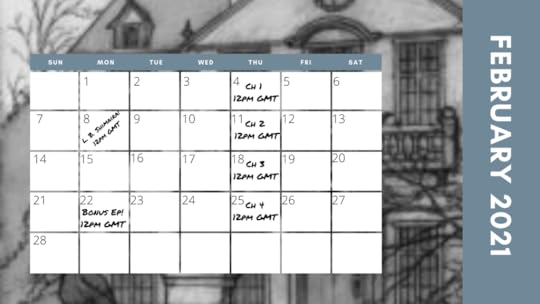 Background Illustration: Fairwood House by Tom Brown4th Feb –
The Crows Chapter 1
~ The Creepy Old House
8th Feb –
Author Interview with L. B. Shimaira
11th Feb –
The Crows Chapter 2
~ A Town With Dark Secrets 18th Feb –
The Crows Chapter 3
~ Meet the Locals
22nd Feb –
Bonus Episode ~ The New Estate and Hangman’s Walk
25th Feb –
The Crows Chapter 4
~ The Grande Dame
Background Illustration: Fairwood House by Tom Brown4th Feb –
The Crows Chapter 1
~ The Creepy Old House
8th Feb –
Author Interview with L. B. Shimaira
11th Feb –
The Crows Chapter 2
~ A Town With Dark Secrets 18th Feb –
The Crows Chapter 3
~ Meet the Locals
22nd Feb –
Bonus Episode ~ The New Estate and Hangman’s Walk
25th Feb –
The Crows Chapter 4
~ The Grande Dame
Each episode will have a companion blog post. For the main chapters, the companion post will give some context to the tropes found in the chapter and quote from the chapter itself. The Author Interviews will all have a full transcript. Not all the bonus episodes will be transcribed in their entirety as I will be reading from other stories and things, but will be paraphrased.
I really hope you enjoy the podcast, and we’ll have more authors coming up in the next few months (one per month!) including Stefanie Simpson, Lyndall Clipstone, Nita Pan, and Maria DeBlassie.
Join the book discussion on Goodreads at the Pagham-on-Sea Tourist Board.
Can’t wait? Check out my YouTube Channel for some fun Q&A and intro videos to Pagham-on-Sea.
January 24, 2021
RedBubble Shop Live! Hangmans-Walk | Redbubble
January 18, 2021
Thirteenth Theme Tune
With revisions and edits of my novel Thirteenth underway and the novel due to be released this year (keep an eye out for the ARC announcement!) it’s time to reveal the theme tune by Gemma Cartmell. It’s the same basic tune as The Crows Theme, but it’s been given the dance treatment.
I asked for something clearly related to The Crows Theme, but reflecting the psychedelic nature of the drug use in the novel by Wes Porter, and the younger protagonist (although it is still Adult, not YA). Fairwood House/The Crows is a main setting, but you see it through the eyes of a jaded 17 year old and her traumatised playboy brother (29). Ricky is also 29 now – he had his birthday in September, and this is set in January, so you missed it. It’s fine, he didn’t want anyone to make a fuss.
It begins with a prologue dated 14 May, before we skip to January. I hope that it’s possible to read Thirteenth as a standalone, or to read it first and then pick up The Crows for a prequel read. Betas seem to think so!
I will be serialising Thirteenth as S2 of the podcast, which will probably begin Autumn 2021.
Katy Porter is seventeen, studying for her A Levels, navigating her brutal family of eldritch monstrosities, and trying to cope with turning into one herself. Except Katy is the thirteenth child of a thirteenth child, and that kind of Change comes with a compulsive taste for her own clan’s flesh. Since she doesn’t have much of a stomach for killing, Katy is really not looking forward to that part. In fairness, neither is anyone else.
The unexpected death of the clan’s matriarch (and Katy’s protector) leaves everyone in turmoil, and Katy without her mentor. If she wants to see her next birthday, she needs allies – but the only two she’s got are Wes and Ricky, both of whom have their own opposing agendas, and who can’t stand the sight of each other.
Wes Porter, Katy’s oldest brother, is a polyamorous, drug-addled playboy pushing thirty whose features are instantly forgettable, and trying to remember what he looks and sounds like has driven people – including one of his partners – to madness. When he swears he wants to protect Katy after voting in favour of killing her, what has prompted his change of heart, and can he really be trusted?
Ricky Porter, their soothsayer cousin, is a killer and a car thief who has ascended into an aura-draining, eyeball-eating eldritch god. Or, at least, that’s what he thinks he is. Wes thinks he’s a prick, and Katy remembers him as a violent thug who punched her dad once at her eleventh birthday party. But Ricky has powers they don’t, some dark secrets of his own, and dangerous forces to contend with.
Katy needs to come to terms with her own monstrosity to stay alive, but she’s not the only one who needs to face what they truly are.
Add it to Goodreads ~ join the discussion in the Goodreads Group
Follow me on Booksprout for ARC releases
Follow me on Twitter for news
January 13, 2021
The Reluctant Husband ~ Sold!
Exciting announcement – my novella The Reluctant Husband is officially part of the SPOOKY BY ASSOCIATION anthology, forthcoming 2021/22 and edited by Nita Pan.
I wrote this novella for anyone who enjoys early weird gothic fiction and doesn’t take it too seriously, but also really wants terrible things to happen to the awful male protagonists.
The year is 1938. Occultist and civil servant, Nathan Montague Porter, is convinced his as-yet undiscovered greatness has at last been recognised by someone – or something – beyond our realm. His dabblings lead him to the dreary coastal town of Pagham-on-Sea and its equally dreary manor, Fairwood House, at the invitation of the ailing Sir Jack Sauvant, who puts Nathan to work on a private, desperate project. Here, Nathan meets the formidable and disquietingly eldritch tea lady Miss Deirdre Wend, who (improbably) seems to hold the key to all the secrets beyond his grasp. However, if he wants to know the cosmic mysteries and find out what’s under her blouse, he’s going to have to take her to the pictures first. Miss Wend is not that sort of eldritch girl.
CW for parasitical/mutation body horror, toxic/misogynistic main character, toxic relationships, and [magical] animal [rodent] experimentation and death.
View this post on InstagramVisit Nita’s profile and view the original post – swipe right for the beautiful individual title graphics! I am 9 of 9!Teaser: The Reluctant HusbandA post shared by Nita Pan (@nitapanwrites)
I first began to suspect the existence of a mysterious benefactor when three coincidences in my life aligned. I had become vaguely aware, since my dabblings with summoning rituals adapted from John Dee’s texts, of someone watching me at night. It is the oddest feeling, the sense of somebody far away peering at me, and my skin reacts as if a myriad of curious eyes are raking over it – yet there is nothing out of the window, no one standing under the streetlights outside, no one in the windows of the houses across the road. I feel it most in dreams, as if I have drawn the attention of someone – or something – that is at a considerable distance, observing me through a telescope. I wake with a jolt, positive someone is in the room. There is never anyone there.
Follow Nita Pan on Twitter and Instagram for further updates and announcements, and if you enjoy their content, consider supporting their Patreon – quality erotic horror, goremance, dark romance and dark fantasy delivered to your inbox for less than the price of a coffee each month.
January 10, 2021
#AmReading ~ The Great God Pan by Arthur Machen
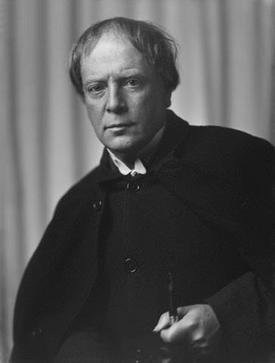 Arthur Machen, born Arthur Llewellyn Jones (1863-1947)
Arthur Machen, born Arthur Llewellyn Jones (1863-1947)My first read of 2021 is a classic, a seminal text in many ways that inspired a generation of Weird fiction writers. Arthur Machen was writing a decadent Gothic novella, which is a kind of fantasy-horror juxtaposing the beauty of the natural world with the unspeakable horror that lies beneath it, on the other side of the veil. Should we try to lift the veil and expose what lurks beneath, it would drive us to madness, sexual excesses, and death. If that sounds like a good time you wait until you see the symbol he uses to represent this unspeakable horror…
CWs: male genitalia and irreverent discussions of a sexual nature, suicide, lobotomy/medical horror, strong language
Jon Gower, reviewing The Great God Pan in the Wales Arts Review, applauds (rightly) Machen’s use of description and his effective use of blank space to keep the unknown … well, unknown. He describes this novella as ‘a Matryoshka confection, a Russian doll full to the brim with seeping, foggy menace, inexplicable deaths and resurrections’. On Machen’s style and use of horror, Gower writes,
Machen won’t show you it all, he is not an explicit writer, where the horror is all described, splatter by splatter. Rather he nudges the reader forward with studied nuance and telling detail, setting his sentences like traps, like the blackest of spiders.
Jon Gower, reviewing The Great God Pan by Arthur Machen in Wales Arts Review, 16.09.2013
In 2016, during the search for the Greatest Welsh Novel (#GWN), critic Phil Morris reviewed this novella too, and concludes that ‘Machen’s powerful capacity to disturb lies not in what is described and explained but what is indicated and unsaid.’ Yes, the prose can be clunky and overblown at times, but that’s sort of the point of a decadent text in which the descriptions are fairly important for Aesthetic reasons. Morris writes,
Its unknowable anti-heroine, its dark implications, its structural lacunae, and its expressions of awe in the face of the ineffable mystery of our universe, directly addresses our concerns regarding the odd impulses that emanate occasionally from our Id, the highly subjective nature of perception, and the limitations of human knowledge. Much scarier than a mere monster is the idea that we don’t really know who we are, why we’re here and what is our purpose.
Phil Morris, #GWN Revisited: The Great God Pan by Arthur Machen, in Wales Arts Review, 03.11.2016
So what is it about? In my view, it’s probably the best film Hammer Horror never made. We start off with middle-aged Dr Raymond talking to his friend Clarke in a lovely Gwent valley about a brain operation he plans to perform on his 17-year-old wife/ward Mary, and the mad doctor has more than a little touch of real-life Dr William Pryce in him. I imagine him as Sir Christopher Lee. Clarke, the friend, is obviously Peter Cushing. The Gwent valley is gorgeously depicted and so familiar to me, and that made it exceptionally jarring as a setting: all a little too close to home. Dr Raymond takes Clarke back to his place, where Clarke falls into a lethargic dream about weirdness in the woods and something lurking beneath natural beauty, brought on by the fumes in the lab. The lab itself has a stone slab rather than an operating table, and when Mary comes in, she is dressed all in white. There is, of course, a knife, and a grisly operation which we do not see. Mary opens her eyes, sees what is beyond the veil of our reality – which, apparently, the ‘ancients’ called ‘seeing the Great God Pan’ – and her face contorts in horror and terror. She becomes insensible and Dr Raymond coldly informs Clarke she is now an incurable “idiot” [in the 1890s medical sense], but that’s okay, because she has seen some stuff.
Clarke had expressed concerns about this procedure, but Dr Raymond said that, since he had rescued Mary from the gutter and starvation as a child, her life was now his to do with as he pleased. I think that line is the most haunting of the lot, for me. It is only right and fair that Mary’s child – apparently conceived in this metaphysical space through the potency of looking at whatever it was she saw, which is all very Merlin-esque – should avenge herself on men in general, but of course Machen doesn’t quite write it that way. It’s how I choose to read it, though.
The B-Movie medical horror scene is also a maiden-sacrifice scene, mixing Frankenstein with druidic menace. We move on to the next section of this epistolary, fragmented novella, to Clarke’s memoirs. Many years have passed, he is now a determined rationalist trying to debunk the notion that there is anything beyond the realm of our reality, but is at the same time unable to totally convince himself that this is the case. He is haunted by Mary, and that weird day he allowed his mad doctor friend to cut open her brain.
Clarke is reading an account of a Helen Vaughan, a young girl who came to a Welsh town and made friends with a local girl Rachel. Helen looks Italian – a dead giveaway that she is the baddie, and will be sexually promiscuous or some sort of femme fatale. It’s also an obvious link to the Classical origins of Pan, who is a symbol of what actually lies behind the veil, so the European Other trope is just there for us as readers to make that leap that she is (a) foreign and don’t belong here, or in this case is clearly otherworldly and (b) has something to do with the Great God Pan and is associated with this symbol. Sure enough, a young boy Trevor sees her in the woods with a strange naked man [the introduction to the satyr as a symbol of horror] and has a seizure. Helen’s friend Rachel goes for an innocent walk in the woods with Helen, and comes back also mad and terrified – clearly something awful has happened to her. Clarke stops reading the account at this point, so we never get to read Rachel’s report of what happened. This is left up to our imaginations.
Since a satyr is typically depicted like this, I think we know what’s been going on, Arthur, yeah.
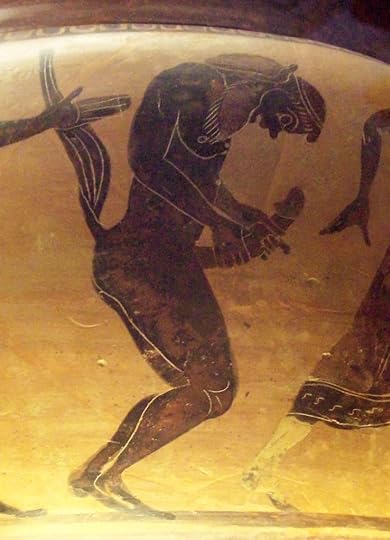 Photo Credit: Luis Garcia, Wikimedia Commons, CC BY-SA 3.0
Photo Credit: Luis Garcia, Wikimedia Commons, CC BY-SA 3.0A silenus masturbating. Detail of side B of a Greek column krater dating to c. 560–550 BC, showing two sileni and a maenad in a Dionysiac scene. Athenian satyr plays were characterized as “a genre of ‘hard-ons.'” [Shaw, Carl A. (2014), Satyric Play: The Evolution of Greek Comedy and Satyr Drama , Oxford, England: Oxford University Press]
Lovecraft: the horror is all the black and brown people
— C. M. Rosens (@CMRosens) January 9, 2021
Machen: oh my god have you seen the fucking size of it lads the horror the unspeakable horror#TeamMachen
I'm sorry, Machen stans, I'm so so sorry
Yes, I live-tweeted this, it’s a whole thread
Helen becomes the central antagonist and mystery of the novella, viewed only through secondhand accounts (by men). Her beauty is described in conjunction with the horror and revulsion it has on the morally upright characters, while the bright young things of Fin-de-Siécle London flock to her drawing room and then go home in paroxysms of lust and hate and kill themselves for no apparent reason, or are found dead of fright in the street not long after leaving. Is Helen Vaughan Mrs Herbert? Is she then also Mrs Beaumont, late of Argentina? Can Clarke (Peter Cushing) and Villiers (obviously a young Vincent Price) figure all this out before it is too late?
The novella is fragmented and you do have to go with the flow of the fragmented narrative as all becomes clear and gets tied up at the end. Sort of. Helen’s ending falls very flat, and Hammer could have done so much with that climactic scene. I would like to see that with Celia Gregory or Madeline Smith, but, sadly, no boobs for us readers. Only horror. Unspeakable horror.
Speaking of which, I think this passage of What The Doctor Saw at the end, where a Dr Richard Matheson’s scribbled Latin notes have been translated and reveal what he witnessed when he came to tend to a certain dying person, remains one of my all-time favourite paragraphs. It’s beautiful body horror, and it manages to cycle through every social anxiety at once in double-time, from sex and gender concerns to the concept of human devolution (which was all wrapped up in the multifarious ‘mainstream’ and academic racist and eugenicist discourses of the time, as well as imperialism and colonialism).
Here is a snippet of that:
“. . . for one instant I saw a Form, shaped in dimness before me, which I will not further describe. But the symbol of this form may be seen in ancient sculptures, and in paintings which survived beneath the lava, too foul to be spoken of . . . as a horrible and unspeakable shape, neither man nor beast, was changed into human form, there came finally death.”
Arthur Machen, The Great God Pan
Honestly, an absolutely cracking start to the New Year. Solid 4*s from me.
In the podcast serialising my first novel (first episode airing 4th Feb 2021) I’ll talk more about this when we get up to Wes Porter’s story of how his family ended up as eldritch abominations. In one of the middle chapters of The Crows, Carrie hears this family origin story in a vague, almost fairy tale, format, and Wes leans in to embracing the well-endowed man in the woods symbol, and all that goes with it. Yes, that family does drive others to madness and death, but, I’ve said it before and I’ll say it again, eldritch girls just want to have fun.

 Tell me your favourite murder family here or Insta! Question in my Instagram story…
Tell me your favourite murder family here or Insta! Question in my Instagram story… 